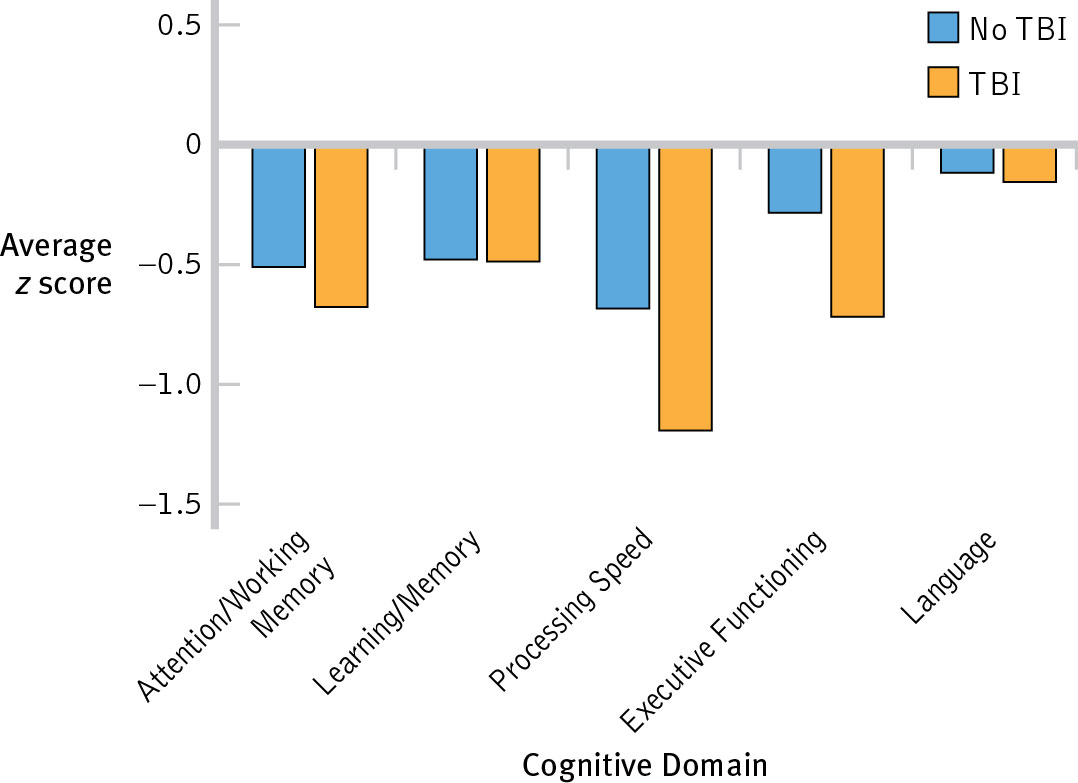Does a Head Injury Last a Lifetime?
1.1 THE NORMAL CURVE, STANDARDIZATION, AND z SCORES: DOES A HEAD INJURY LAST A LIFETIME?1 of 9
Welcome
Does a Head Injury Last a Lifetime?
Authors:
Kelly M. Goedert, Seton Hall University
Susan A. Nolan, Seton Hall University
Kaylise D. Algrim, Seton Hall University

Traumatic brain injury (TBI)—a disruption to normal brain functioning caused by a blow to the head—has received a lot of media attention lately, largely because it is a problem for National Football League players. But traumatic brain injury is not new to the medical community, as it has always plagued members of the military. Although TBI has obvious short-term consequences, those symptoms typically disappear with time.
1.2 THE NORMAL CURVE, STANDARDIZATION, AND z SCORES: DOES A HEAD INJURY LAST A LIFETIME?2 of 9
Participants in this study were 169 veterans, age 50 or older, living in one of two veterans retirement homes in the United States. The researchers determined that 88 of the participants had a history of TBI at some point in their lifetime, while 81 had no history of TBI. The researchers reported, “Participants completed a comprehensive neuropsychology battery, an expanded version of the Alzheimer’s Disease Centers’ Uniform Data Set battery. . . . This battery was comprised of measures assessing cognitive functioning in five domains: (1) attention/working memory, (2) learning/memory, (3) language, (4) processing speed, and (5) executive functioning” (p. 58). Note that each of these five domains was assessed by multiple measures or tests of that domain. The researchers wanted to create a single score in each of the domains for each participant in the study.
1.3 THE NORMAL CURVE, STANDARDIZATION, AND z SCORES: DOES A HEAD INJURY LAST A LIFETIME?3 of 9
The researchers went on to say, “[W]e converted each individual’s raw test score into age-corrected z scores, reflecting the extent to which an individual’s test performance diverges from that of healthy, age-matched peers [from existing large normative data sets] . . . [I]ndividuals’ z scores for individual tests within a cognitive domain were averaged to create five cognitive domain composite scores: attention/working memory, learning/memory, language, processing speed, and executive functioning composites” (p. 85).
1.4 THE NORMAL CURVE, STANDARDIZATION, AND z SCORES: DOES A HEAD INJURY LAST A LIFETIME?4 of 9
Recall that the researchers indicated, “[W]e converted each individual’s raw test score into age-corrected z scores, reflecting the extent to which an individual’s test performance diverges from that of healthy, age-matched peers [from existing large normative data sets] . . . [I]ndividuals’ z scores for individual tests within a cognitive domain were averaged to create five cognitive domain composite scores: attention/working memory, learning/memory, language, processing speed, and executive functioning composites” (p. 85). Imagine a participant had an average z score of –1.00 in the domain of attention/working memory.
1.5 THE NORMAL CURVE, STANDARDIZATION, AND z SCORES: DOES A HEAD INJURY LAST A LIFETIME?5 of 9

This graph represents the results of the study.
1.6 THE NORMAL CURVE, STANDARDIZATION, AND z SCORES: DOES A HEAD INJURY LAST A LIFETIME?6 of 9
Recall that the researchers were investigating whether veterans who have a history of TBI have different patterns of cognitive decline than veterans with no history of TBI. The graph representing the results of the study is again shown here.

1.7 THE NORMAL CURVE, STANDARDIZATION, AND z SCORES: DOES A HEAD INJURY LAST A LIFETIME?7 of 9

The graph representing the results of the study is again shown here. From the graph, we can see that the TBI group had an average z score of approximately –1.20 for the domain of processing speed.
1.8 THE NORMAL CURVE, STANDARDIZATION, AND z SCORES: DOES A HEAD INJURY LAST A LIFETIME?8 of 9

Clinical psychologists and neuropsychologists often use normative test batteries for determining whether an individual’s performance falls outside of the normal range, indicating some kind of impairment.
1.9 THE NORMAL CURVE, STANDARDIZATION, AND z SCORES: DOES A HEAD INJURY LAST A LIFETIME?9 of 9
The bottom line: Head injuries may indeed have consequences that last a lifetime, but they may have lasting consequences for only some cognitive functions and not others.

REFERENCES
Kaup, A. R., Peltz, C., Kenney, K., Kramer, J. H., Diaz-Arrastia, R., & Yaffe, K. (2017). Neuropsychological profile of lifetime traumatic brain injury in older veterans. Journal of the International Neuropsychological Society, 23, 56–64. https://doi.org/10.1017/S1355617716000849